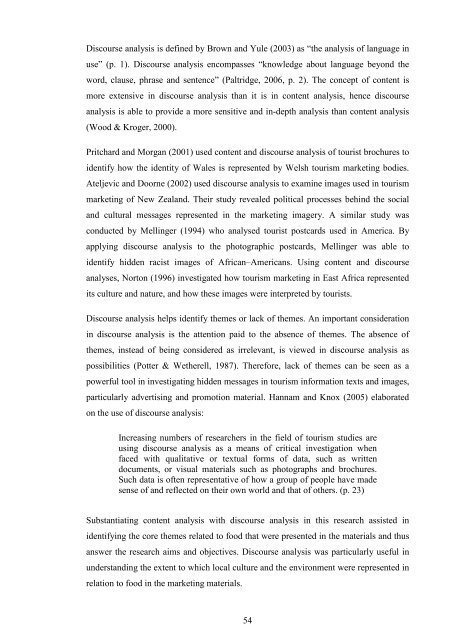The Role of Local Food in Maldives Tourism - Scholarly Commons ...
The Role of Local Food in Maldives Tourism - Scholarly Commons ...
The Role of Local Food in Maldives Tourism - Scholarly Commons ...
You also want an ePaper? Increase the reach of your titles
YUMPU automatically turns print PDFs into web optimized ePapers that Google loves.
Discourse analysis is def<strong>in</strong>ed by Brown and Yule (2003) as “the analysis <strong>of</strong> language <strong>in</strong><br />
use” (p. 1). Discourse analysis encompasses “knowledge about language beyond the<br />
word, clause, phrase and sentence” (Paltridge, 2006, p. 2). <strong>The</strong> concept <strong>of</strong> content is<br />
more extensive <strong>in</strong> discourse analysis than it is <strong>in</strong> content analysis, hence discourse<br />
analysis is able to provide a more sensitive and <strong>in</strong>-depth analysis than content analysis<br />
(Wood & Kroger, 2000).<br />
Pritchard and Morgan (2001) used content and discourse analysis <strong>of</strong> tourist brochures to<br />
identify how the identity <strong>of</strong> Wales is represented by Welsh tourism market<strong>in</strong>g bodies.<br />
Ateljevic and Doorne (2002) used discourse analysis to exam<strong>in</strong>e images used <strong>in</strong> tourism<br />
market<strong>in</strong>g <strong>of</strong> New Zealand. <strong>The</strong>ir study revealed political processes beh<strong>in</strong>d the social<br />
and cultural messages represented <strong>in</strong> the market<strong>in</strong>g imagery. A similar study was<br />
conducted by Mell<strong>in</strong>ger (1994) who analysed tourist postcards used <strong>in</strong> America. By<br />
apply<strong>in</strong>g discourse analysis to the photographic postcards, Mell<strong>in</strong>ger was able to<br />
identify hidden racist images <strong>of</strong> African–Americans. Us<strong>in</strong>g content and discourse<br />
analyses, Norton (1996) <strong>in</strong>vestigated how tourism market<strong>in</strong>g <strong>in</strong> East Africa represented<br />
its culture and nature, and how these images were <strong>in</strong>terpreted by tourists.<br />
Discourse analysis helps identify themes or lack <strong>of</strong> themes. An important consideration<br />
<strong>in</strong> discourse analysis is the attention paid to the absence <strong>of</strong> themes. <strong>The</strong> absence <strong>of</strong><br />
themes, <strong>in</strong>stead <strong>of</strong> be<strong>in</strong>g considered as irrelevant, is viewed <strong>in</strong> discourse analysis as<br />
possibilities (Potter & Wetherell, 1987). <strong>The</strong>refore, lack <strong>of</strong> themes can be seen as a<br />
powerful tool <strong>in</strong> <strong>in</strong>vestigat<strong>in</strong>g hidden messages <strong>in</strong> tourism <strong>in</strong>formation texts and images,<br />
particularly advertis<strong>in</strong>g and promotion material. Hannam and Knox (2005) elaborated<br />
on the use <strong>of</strong> discourse analysis:<br />
Increas<strong>in</strong>g numbers <strong>of</strong> researchers <strong>in</strong> the field <strong>of</strong> tourism studies are<br />
us<strong>in</strong>g discourse analysis as a means <strong>of</strong> critical <strong>in</strong>vestigation when<br />
faced with qualitative or textual forms <strong>of</strong> data, such as written<br />
documents, or visual materials such as photographs and brochures.<br />
Such data is <strong>of</strong>ten representative <strong>of</strong> how a group <strong>of</strong> people have made<br />
sense <strong>of</strong> and reflected on their own world and that <strong>of</strong> others. (p. 23)<br />
Substantiat<strong>in</strong>g content analysis with discourse analysis <strong>in</strong> this research assisted <strong>in</strong><br />
identify<strong>in</strong>g the core themes related to food that were presented <strong>in</strong> the materials and thus<br />
answer the research aims and objectives. Discourse analysis was particularly useful <strong>in</strong><br />
understand<strong>in</strong>g the extent to which local culture and the environment were represented <strong>in</strong><br />
relation to food <strong>in</strong> the market<strong>in</strong>g materials.<br />
54

















